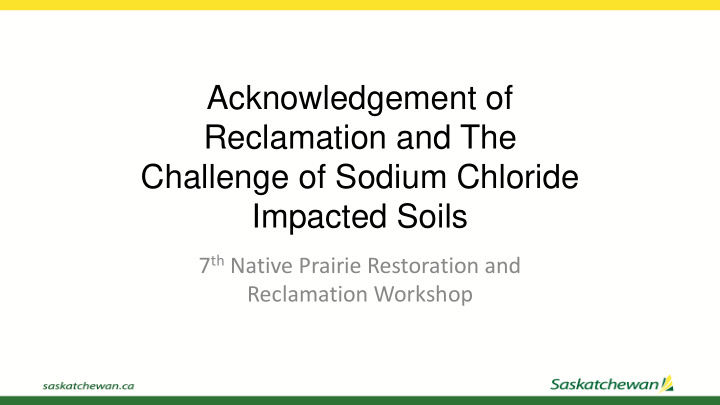



Acknowledgement of Reclamation and The Challenge of Sodium Chloride Impacted Soils 7 th Native Prairie Restoration and Reclamation Workshop
Introduction • What is an Acknowledgement of Reclamation (AOR)? • What is produced water and (Sodium Chloride) NaCl? • How does Produced Water/NaCl get released into the environment? • How Big is The Issue? • How can we receive an AOR whilst leaving NaCl impacts in place • Case Study: The Torc Experience
Acknowledgement of Reclamation (AOR) • upon abandonment of a well or decommissioning of a facility, the respective site is to be assessed, decommissioned and reclaimed and the licensee is to submit a report which substantiates the satisfactory reclamation of the site. The application for Acknowledgement of Reclamation (AOR) serves as the report.
What is NaCl? Produced water is a by product of oil and gas production Generally the dominant salt in produced water is NaCl Cl is essentially inert as it is not readily used in biological systems and does not degrade over time. Therefore once it is released to the environment it does not disappear but rather just moves about. This movement is facilitated by ground water/surface water, as it being a salt it is very soluble and moves where the water moves.
How Does NaCl Get Released to the Environment? • Earthen pits (used at one time to store/dispose of oilfield related fluids) • Flow lines failures • Well Head releases • Drilling fluids disposal • Releases from storage tanks
What Are Some Signs Of NaCl Impacts? • Soil compaction/hard pan • Soil sterilization • Impacting ground water supplies making it unusable for human/livestock consumption without treatment • Impacting surface water negatively impacting biota and making it unusable for human/livestock consumption
Purpose Allow licensees to obtain regulatory closure on sodium chloride impacted sites that would be prohibitively large to remediate where it can be shown through extensive site investigation that there is a low probability of an impact to an environmental receptor. As a regulator ER needs to develop a pragmatic method to remediate these sites so that work can begin, closure can be obtained and they do not enter the Saskatchewan Orphan Fund. 7
Amendment to Acknowledgement of Reclamation (AOR) Directive PNG016 Provides a new type of AOR approvals: Routine AOR (old) Non-Routine AOR (old) Risk Assessed AOR (New!!!!!) • This may include administrative controls
How Big is The Issue?
How Big is The Issue?
How Big Is The Issue?
Why Shouldn’t You Remediate To Generic Guidelines? Impacted areas are very large Depth of impacts are very deep In-Situ Remediation like ground water recovery takes too long/ineffective No really good way for Ex-Situ treatment Not enough resources to remediate all of the NaCl impacted sites in the province. Excavations are just transporting the problem to a different location to be managed. The Contaminant of concern is table salt = low health risk.
What We Have Done In The Past Current remediation practices consist of 4 things: 1) Do nothing 2) Prohibitively large surface excavations 3) Long term monitoring 4) In Situ treatment with no path to closure 13
New Remediation Approach If the site investigation shows: If NaCL impacts remain in place there is no risk to receptors (surface water, ground water, rooting zone, etc.) it can remain in place Do natural conditions already inhibit the use of an environmental receptor. Therefore are we remediating an area to better than background conditions If we can demonstrate that NaCl impacts will not be an issue if they are remobilized can we apply administrative controls to limit the land use to ensure the impacts are remobilized. For example limit the construction of dugouts and water wells. Since we are working outside of guidelines/criteria need to have a technical third party audit administered by the Government to ensure the work completed is defensible.
Project Challenges Deliverable definition How stringent should we be considering the health risk associated with NaCl (table salt): Balancing project constraints: • Path to closure (uncertainty) • Environmental protection (receptor based rather than guideline based) • Remediation cost Third party technical Audit: • How do you get one environmental firm to approve another firms work?? Stakeholder communication regarding leaving NaCl impacts In Situ
Case Study : The TORC Experience TORC has a historic battery site with an flare pit. Moving forward with administrative controls this summer. Hoping to apply learnings from this project to other projects within industry Third party technical audit indicates that the approach takes is defensible Big thanks to Jim Gordon from TORC for volunteering a site as a case study.
Case Study: The TORC Experience Only receptor being impacted is the rooting zone. Rooting zone is negatively impacted in areas that would already demonstrate reduce growth due to natural conditions. The Na Cl plume is stable and not migrating as it is in a tight glacial till. No future risk to receptors as long as the impacts are not remobilized. Will apply and administrative control to ensure that NaCl impacts are not remobilized. Ie) restriction to construction projects like dugouts and water wells. A payment will be given to the landowner for a possible reduced resale value since an interest will be on the land and limiting future land use.
Main Consideration There are thousands of NaCl impacted sites. How can we ensure that these NaCl impacted sites are retired in the most responsible way possible? Keep sites progressing by supplying solutions Ensure it doesn’t appear that oil and gas is buying their way out of their environmental liability by applying good science to the problem
You Could be a Jim!!! Do you have NaCl impacted sites? Let us know and work with us on regulatory closure of your NaCl impacted site. Be a case study!
Contact Information Jonas Fenn Remediation and Reclamation Manager Liability Management Ministry of Energy and Resources Jonas.Fenn@gov.sk.ca Sean Trithardt Environmental Engineer Liability Management Ministry of Energy and Resources Sean.Trithardt@gov.sk.ca
Recommend
More recommend